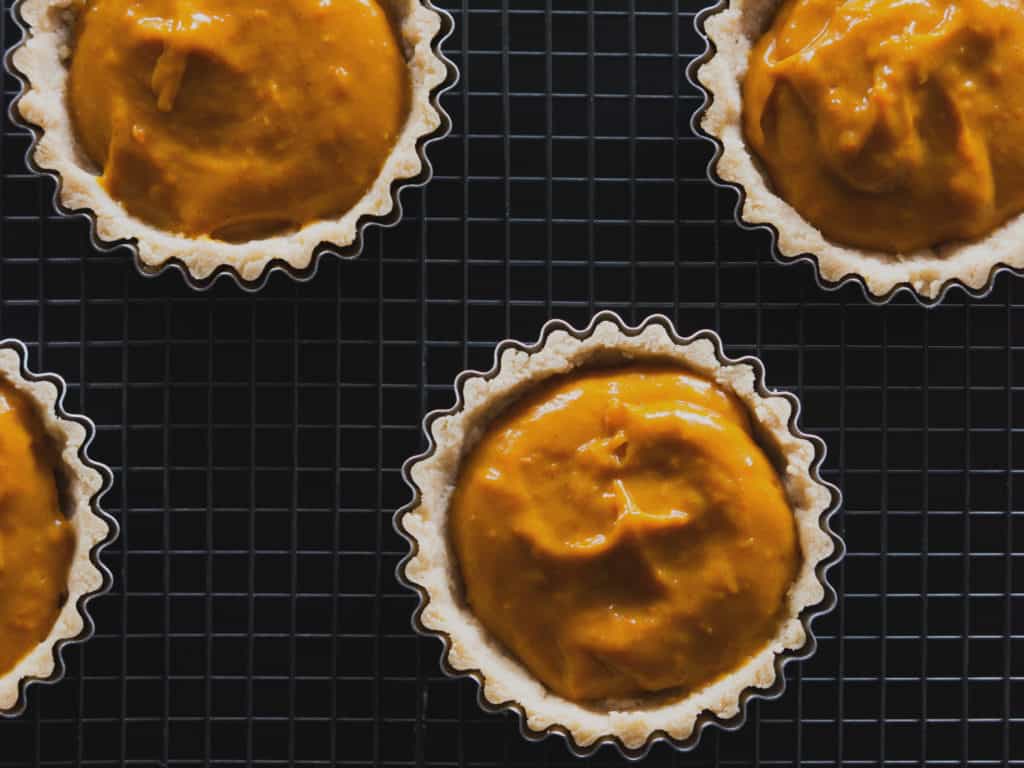
This Super Decadent Gluten Free, Vegan Sweet Pumpkin Tart is amazing as a sweet treat anytime of year when pumpkin or squash are in season. Perfect for autumnal weekend treat and fabulous at Halloween (great for using up all that left over pumpkin from scary carvings!). The tarts are super tasty and very colourful! The light, crumbly texture of the almond tart crust is perfect with the sweet and delicate squash filling.
This will make approximately six, small, 8 centimetre tart cases or one, large, 28 centimetre tart case. The tart cases can be frozen before filling.
Gluten Free, Vegan Sweet Pumpkin Tart is easy to medium to make due to the time taken to make the tart case ahead of the tart.
You can find the full Gluten Free, Vegan Sweet Pumpkin Tart recipe here.
If you have the prepared and pre-baked Sweet Almond Tart Crust (which you can freeze and use from frozed) and prepared (unseasoned) roasted squash/ pumpkin (which you can also freeze) this tart will only take around 35 minutes to prepare.
Top tip! For an extra special topping roast the squash seeds in oil with a 0.25 teaspoon of salt and 0.25 teaspoon sugar until golden and crispy. Once cool blitz to a powder in a food processor and sprinkle lightly on the centre of the tart(s). You can use any type of edible squash or pumpkin for this tart. They will all work really well.
Preparation
Difficulty easy to medium
Preparation time 20 mins (if you have the prepared tart crust and pumpkin/ squash – 60 minutes if not)
Cooking time 15 mins
You can find the full Gluten Free, Vegan Sweet Pumpkin Tart recipe here.
Allergens
Sweet Pumpkin Tart is gluten-free and vegan as well as…
Celery free
Coconut free
Garlic free
Lupin free
Mustard free
Nightshade free
Onion free
Peanut free
Sesame free
Soya free
About
Pumpkin and squash tend to be used interchangeably sometimes without any real clarity of what a pumpkins is and what a squash is. Well, to keep it simple and pumpkin is a type of squash and a squash is a type of gourd… To make it more confusing in the UK, Australia and New Zealand the term pumpkin is used where winter squash would be used elsewhere.
Cucurbita is a genus of herbaceous vines in the gourd family which is native to the Andes and Mesoamerica. Five species are grown worldwide for their edible fruit and seeds. These species are known as squash, pumpkin, or gourd depending on variety, and local parlance. Squash were first cultivated in the Americas before being brought to Europe by returning explorers after their discovery of the New World. There are other types of gourd (bottle-gourds) which are native to Africa and belong to the genus Lagenaria, which is in the same family and subfamily as Cucurbita but in a different tribe. These other gourds are used as utensils or vessels, and their young fruits are eaten much like those of Cucurbita species.
Cucurbita fruits have played a role in human culture for at least 2000 years. They are often represented in Moche ceramics from Peru. After Christopher Columbus’s arrival in the New World, paintings of squashes started to appear in Europe early in the sixteenth century. The fruits have many culinary uses including pumpkin pie, biscuits, bread, desserts, puddings, beverages, and soups. Pumpkins and other Cucurbita fruits are celebrated in festivals and in flower and vegetable shows in many countries.
The genus Cucurbita were present in the Americas before the arrival of humans and are native to the New World. The likely origin is southern Mexico, spreading south through what is now known as Mesoamerica, on into South America, and north to what is now the southwestern United States. Modern-day cultivated Cucurbita are not found in the wild.
The earliest known evidence of the domestication of Cucurbita dates back at least 8000 years, predating the domestication of other crops such as maize and beans in the region by about 4000 years. Squash was domesticated first, followed by maize and then beans, becoming part of the Three Sisters agricultural system of companion planting. The English word “squash” derives from askutasquash (a green thing eaten raw), a word from the Narragansett language, which was documented by Roger Williams, the founder of Rhode Island, in his 1643 publication A Key Into the Language of America. Similar words for squash exist in related languages of the Algonquian family.
Long before Europeans discovered the America, Cucurbita was a major food source for the native peoples of the Americas. The species subsequently became an important food for European settlers, including the Pilgrims (featuring at the first Thanksgiving). Commercially made pumpkin pie mix is very popular in the US as a sweet and savoury ingredient. Squash is used throughout Europe, Africa and America in almost every type of dish including soup, scones, biscuits, bread, cheesecake, desserts, donuts, granola, ice cream, gnocchi, pancakes, pudding, salads, soups, stuffing etc.
Nutritionally squash contains vitamins A and C although varieties vary in their nutritional value. As an example Curcubita, raw summer squash is 94% water, 3% carbohydrate, 1% protein, with negligible fat content. 100 grams of raw squash will supply 16 kilo-calories and contains 20% of the RDA of vitamin C and 12–17% RDA of vitamins B6 and riboflavin. Curcubita seeds contain vitamin E, crude protein, B vitamins and several dietary minerals. Also present in pumpkin seeds are unsaturated and saturated oils (palmitic, oleic and linoleic fatty acids) and carotenoids.